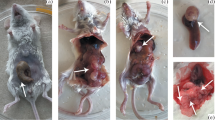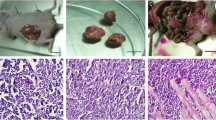Abstract
COL-2-JCK, a human colon cancer xenograft line able to be transplanted into nude mice, was implanted in the subserosal layer of the cecum, either as cancer tissue or as a single cell suspension. When cancer tissue was used for the cecal implantation, 100% extensive local tumor growth and a high incidence of metastases to the regional lymph nodes, peritoneum, liver, and lung was observed. In contrast, when the cell suspension of this line was injected into the cecal wall, no metastases were observed, with significantly reduced local tumor growth. The use of cancer tissue maintaining the original cancer tissue structure is therefore considered imperative for allowing full expression of the biological characteristics of cancer cells. This nude mouse model using the cecal implantation of cancer tissue should thus prompt further study on the biology of human colon cancer.
Similar content being viewed by others
References
Giovanella BC, Yim SO, Stehlin JS, Williams LJ (1972) Development of invasive tumors in the “nude” mouse after injection of cultured human melanoma cells. J Natl Cancer Inst 48:1531–1533
Shimosato Y, Kameya T, Nagai K, Hirohashi S, Koide T, Hayashi H, Nomura T (1976) Transplantation of human tumors in nude mice. J Natl Cancer Inst 56:1251–1260
Sharkey FE, Fogh J (1984) Consideration in the use of nude mice for cancer research. Cancer Metastasis Rev 3:341–360
Sharkey FE, Fogh J (1979) Metastasis of human tumors in athymic nude mice. Int J Cancer 24:733–738
Kyriazis AP, DiPersio L, Michael GJ, Pesce AJ, Stinnett JD (1978) Growth patterns and metastatic behaviour of human tumors growing in athymic mice. Cancer Res 38:3186–3190
Fidler IJ (1986) Rationale and methods for the use of nude mice to study the biology and therapy of human cancer metastasis. Cancer Metastasis Rev 5:29–49
Fidler IJ (1990) Critical factors in the biology of human cancer metastasis: Twenty-eighth G. H. A. Clowes memorial award lecture. Cancer Res 50:5130–5138
Giavazzi R, Jessup JM, Cambell DE, Walker SM, Fidler IJ (1986) Experimental nude mouse model of human colorectal cancer liver metastases. J Natl Cancer Inst 77:1303–1308
Bresalierr S, Raper SE, Hujanen ES, Ken YS (1987) A new animal model for human colon cancer metastasis. Int J Cancer 39:625–630
Morikawa K, Walker SM, Jessup JM, Fidler IJ (1988) In vivo selection of highly metastatic cells from surgical specimens of different human colon carcinomas implanted into nude mice. Cancer Res 48:1943–1948
Morikawa K, Walker S, Nakajima M, Pathak S, Jessup JM, Fidler IJ (1988) Influence of organ environment on the growth, selection, and metastasis of human colon carcinoma cells in nude mice. Cancer Res 48:6863–6871
Fu X, Theodorescu D, Kerbel RS, Hoffman RM (1991) Extensive multi-organ metastasis following orthotopic implantation of histologically-intact human bladder carcinoma tissue in nude mice. Int J Cancer 49:938–939
Fu X, Besterman JM, Hoffman RM (1991) Models of human metastatic colon cancer in nude mice orthotopically constructed by using histologically-intact patient specimens. Proc Natl Acad Sci USA 88:9345–9349
Yamada Y, Nakatani K, Watanabe A, Okumura T, Yano T, Yamada Y, Nakano H (1990) Expression of malignant potential of human colon cancer in nude mice: Preliminary report (in Japanese). Nippon Geka Gakkai Zasshi (J Jpn Surg Soc) 91:787
Hoffman RM (1991) Three-dimensional histoculture: Origins and applications in cancer research. Cancer Cells 3:86–92
Thompson JA, Anderson KD, DiPietro JM, Zwiebel JA, Zametta M, Anderson WF, Maciag T (1988) Site-directed neovessel formation in vivo. Science 241:1349–1352
Vasiliev JM (1958) The role of connective tissue proliferation in invasive growth of normal and malignant tissues: A review. Br J Cancer 12:524–536
Folkman J (1972) Anti-angiogenesis: New concept for therapy of solid tumors. Ann Surg 175:409–416
Arisawa Y (1991) The role of host immune defense mechanism in experimental hepatic metastases of murine colon carcinoma, Colon-26, with reference to NK activity modulated by OK-432 (in Japanese with English abstract). Keio Igaku 68:155–164
Author information
Authors and Affiliations
Rights and permissions
About this article
Cite this article
Furukawa, T., Kubota, T., Watanabe, M. et al. A metastatic model of human colon cancer constructed using cecal implantation of cancer tissue in nude mice. Surg Today 23, 420–423 (1993). https://doi.org/10.1007/BF00309500
Received:
Accepted:
Issue Date:
DOI: https://doi.org/10.1007/BF00309500




